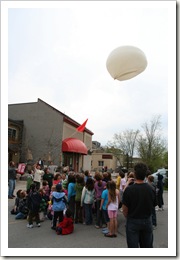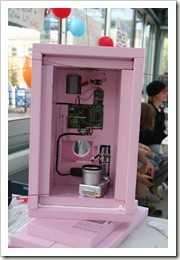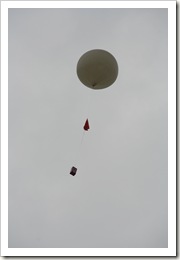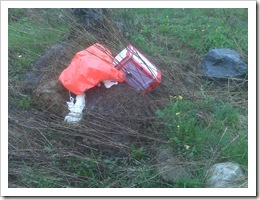Lessons learned from chasing balloons
 Last weekend, I headed out with Darin (VE3OIJ) to help chase a pair of weather balloons that were being launched from Perth by the Lanark Space Agency (LASA). One of the balloons, VE3LCA-11, had a payload with a GPS, camera, temperature sensor and an APRS beacon. It’s goal was to take pictures over the course of its flight for the Grades 5 and 6 students from St. John’s School it was being launched for.
Last weekend, I headed out with Darin (VE3OIJ) to help chase a pair of weather balloons that were being launched from Perth by the Lanark Space Agency (LASA). One of the balloons, VE3LCA-11, had a payload with a GPS, camera, temperature sensor and an APRS beacon. It’s goal was to take pictures over the course of its flight for the Grades 5 and 6 students from St. John’s School it was being launched for.
The launch was well-attended by students, parents, visitors to the farmers’ market and many of the chase teams. After the obligatory group photo with the students and the balloon, they did a count down and released the balloon and its payload. It disappeared into the clouds about 4500’ AGL, so we watched its progress on the display they had set up for people to watch.
Meanwhile, the second balloon, VE3REX-11 (aka LASA 4), was prepped for launch. It’s goal was to set an altitude record for amateur weather balloons. It’s payload consisted solely of a small GPS and an APRS beacon, which weighed less than the first balloon. It was launched off in due order, so we headed off, stopping only to buy some homemade cookies from the farmers’ market.
| We decided to chase VE3LCA-11 since its payload needed to be retrieved more than VE3REX-11’s. |  |
Tracking the balloon was fairly straight-forward, at least for our team, because we had my Kenwood TM-D710A, which provides a range and bearing for each APRS beacon it hears. We were also in contact with Bob (VA3QV) who was tracking it, and the chase teams that had APRS capabilities, at home and was providing updates with a little more context than a bearing and range. Darin was also accessing position updates via his phone.
We watched as it moved downrange at a fair clip while gaining altitude. Suddenly, it almost came to a full stop horizontally, but gaining altitude at a rate of something like 5000 to 10000 fpm. My theory is that it was sucked into a cloud of vertical development like a cumulonimbus (CB) or towering cumulus cloud (TCU). These tops of these clouds can be as high as 60000’ or 80000’, so a balloon caught in one of these gets an express elevator ride up before being spat out the top.
 (This probably saved us a huge amount of driving because it was looking like we were going to have to cross into the US to retrieve the payload before this happened.)
(This probably saved us a huge amount of driving because it was looking like we were going to have to cross into the US to retrieve the payload before this happened.)
Eventually, it was determined that the balloon had popped after reaching more than 111 000’ and that the payload would likely land near Cornwall. Just before it landed, one of the other chase teams actually saw it disappear behind the trees, so we converged on his location and started searching the forest.
Darin entered the coordinates into the GPS and quickly realized that the precision of the coordinates we could get would give us a radius of about 70m to search. Darin and I continued to search using our finely honed geocaching techniques and quickly eliminated much of the 70m radius while the other continued to search the forest.
At that point, Darin returned to the spot where the balloon was last spotted from while I talked to Bob and tried to get a better description of the location. Everything came back to a building in the middle of an open area, so we circled the building at some distance in hopes of seeing whether it was on the roof. After climbing a rather dodgy wall made out of giant concrete blocks surrounding a huge pile of broken glass, I decided that a little tree climbing would be in order, so we made out way to a large pine tree on the other side of the building.
 As we approached the tree, Darin spotted the payload sitting in the middle of field about 30m away from the tree. We took the obligatory FTF photos, notified the other searchers and awaited the arrival of some of the students who were with one of the chase teams. They arrived bearing coffee cake, so we took photos, ate cake and eventually opened payload to retrieve the camera.
As we approached the tree, Darin spotted the payload sitting in the middle of field about 30m away from the tree. We took the obligatory FTF photos, notified the other searchers and awaited the arrival of some of the students who were with one of the chase teams. They arrived bearing coffee cake, so we took photos, ate cake and eventually opened payload to retrieve the camera.
The camera took some stunning photos, though the ones at extreme altitude were blurry because the housing frosted up. Still, you could make out the curvature of the Earth in the photos, which is very cool. We then adjourned to a restaurant in Cornwall for lunch and beer.
At lunch we learned the fate of the other balloon. It landed in the St. Lawrence River, about 20’ offshore. Happily, a cottager happened to see it land in the river and retrieved it and called the phone number on the payload. So, both payloads were retrieved.
Though neither balloon set the altitude record, one of them did manage to take third place with 121,134’. (Second place is held by a balloon this group launched last November.)
So, a number of lessons for the next time were learned.
First: If you have an APRS beacon in your car, you need to ensure it’s not set to beacon so frequently that no one else can use the frequency. One of the other chase teams was beaconing out its location every 15 or 20 seconds, making it very difficult for anyone near them to send out their location or receive updates from the balloons. (This is a rule that can be applied to anyone transmitting APRS packets.)
Second: Have a search strategy planned in advance so that the payload can be found quickly. In an ideal world, you would stop at the side of the road, hop out and pick up the payload. In the real world, the payload is not going to be visible and if you’re lucky someone will be able to point in the direction they saw it before it disappeared. A compass in this situation to help you walk in the direction they’re pointing would be an asset. (This, of course, requires that you know how to use the compass.)
Third: Repeaters are an excellent way to communicate over great distances with low-power radios. We used a couple of different repeaters to communicate with Bob back in Ottawa while we were on the 401. But the chase teams should use simplex communications whenever possible since you can quickly go out of range of the repeaters. (As an aside, you should always use simplex when you’re trying to talk to the person in the car ahead of you.)
Fourth: Have a meeting with all the chase teams prior to launching the balloons. People should agree who is going to chase which balloon and which simplex frequency will be used by each group of chasers. Ideally, a quick reference sheet with the teams, frequencies, balloon IDs, etc, should be handed out.
All in all, Darin and I had a great time and I’m looking forward to the next balloon launch I can help retrieve in the future!



 AKA Keeper of Maps, I'm a geocacher who lives in Ottawa, Canada.
AKA Keeper of Maps, I'm a geocacher who lives in Ottawa, Canada.

Nice bolgs, good job, 73…